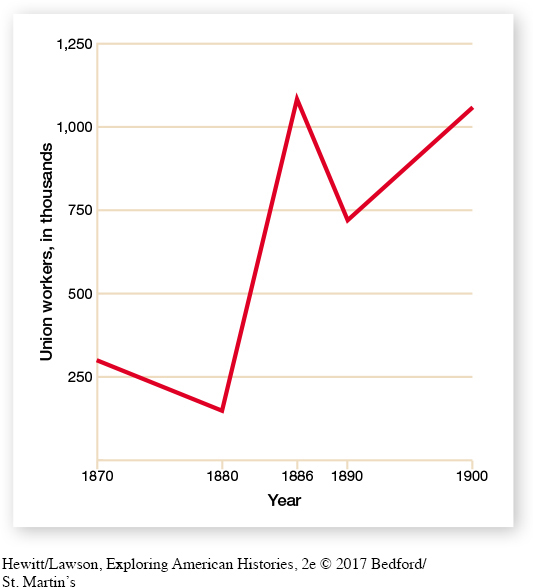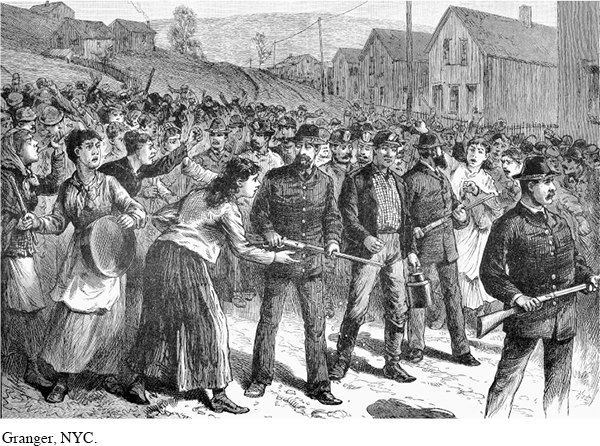Organizing Unions
Faced with improving but inadequate wages and with hazardous working conditions, industrial laborers sought to counter the concentrated power of corporate capitalists by joining forces. They attempted to organize unions—groups of workers seeking rights and benefits from their employers through their collective efforts. Union organizing was prompted by attitudes that were common among employers. Most employers were convinced that they and their employees shared identical interests, and they believed that they were morally and financially entitled to establish policies on their workers’ behalf. They refused to engage in negotiations with labor unions (a process known as collective bargaining). Although owners appreciated the advantages of companies banding together to eliminate competition or to lobby for favorable regulations, similar collective efforts by workers struck them as unfair, even immoral. It was up to the men who supplied the money and the machines—rather than the workers—to determine what was a fair wage and what were satisfactory working conditions. In 1877 William H. Vanderbilt, the son of transportation tycoon Cornelius Vanderbilt, explained this way of thinking: “Our men feel that although I . . . may have my millions and they the rewards of their daily toil, still we are about equal in the end. If they suffer, I suffer, and if I suffer they cannot escape.” Needless to say, many workers disagreed.
Industrialists expected their paternalistic values to reduce grievances among their workforce. They sponsored sports teams, set up social clubs, and offered cultural activities. The railroad magnate George Pullman built a model village to house his workers. In return, capitalists demanded unquestioned loyalty from their employees.
Yet a growing number of working people failed to see the relationship between employer and employee as mutually beneficial. Increasingly, they considered labor unions to be the best vehicle for communication and negotiation between workers and owners. Though not the first national workers’ organization, the Noble Order of the Knights of Labor, founded by Uriah Stephens in 1869, initiated the most extensive and successful campaign after the Civil War to unite workers and challenge the power of corporate capitalists. “There is no mutuality of interests . . . [between] capital and labor,” the Massachusetts chapter of the Knights proclaimed. “It is the iron heel of a soulless monopoly, crushing the manhood out of sovereign citizens.” In fact, the essential premise of the Knights was that all workers shared common interests that were very different from those of owners.
The Knights did not enjoy immediate success and did not really begin to flourish until Terence V. Powderly became Grand Master of the organization in 1879. Powderly advocated the eight-hour workday, the abolition of child labor, and equal pay for women. Under his leadership, the Knights accepted African Americans, immigrants, and women as members, though they excluded Chinese immigrant workers, as did other labor unions. As a result, the Knights experienced a surge in membership from 9,000 in 1879 to nearly a million in 1885, about 10 percent of the industrial workforce.
Rapid growth proved to be a mixed blessing. As membership grew, Powderly and the national organization exercised less and less control over local chapters. In fact, local chapters often defied the central organization by engaging in strikes, a tactic Powderly had officially disavowed. Nonetheless, members of the Knights struck successfully against the Union Pacific Railroad and the Missouri Pacific Railroad in 1885. The following year, on May 1, 1886, local assemblies of the Knights joined a nationwide strike to press for an eight-hour workday. However, this strike was soon overshadowed by events in Chicago that would prove to be the undoing of the Knights (Figure 17.1).

For months before the general strike, the McCormick Harvester plant in Chicago had been at the center of an often violent conflict over wages and work conditions. On May 3, 1886, police killed two strikers in a clash between union members and strikebreakers who tried to cross the picket lines. In response, a group of anarchists led by the German-born activist August Spies called for a rally in Haymarket Square to protest police violence. Consisting mainly of foreign-born radicals, such anarchists believed that government represented the interests of capitalists and stifled freedom for workers. Anarchists differed among themselves, but they generally advocated tearing down government authority, restoring personal freedom, and forming worker communes to replace capitalism. To achieve their goals, anarchists like Spies advocated the violent overthrow of government.
The Haymarket rally began at 8:30 in the evening of May 4 and attracted no more than 1,500 people, who listened to a series of speeches as rain fell. By 10:30 p.m., when the crowd had dwindled to some 300 people, 180 policemen decided to break it up. As police moved into the square, someone set off a bomb. The police fired back, and when the smoke cleared, seven policemen and four protesters lay dead. Most of the fatalities and injuries resulted from the police crossfire. A subsequent trial convicted eight anarchists of murder, though there was no evidence that any of them had planted the bomb or used weapons. Four of them, including Spies, were executed. Although Powderly and other union leaders denounced the anarchists and the bombing, the incident greatly tarnished the labor movement. Capitalists and their allies in the press attacked labor unionists as radicals prone to violence and denounced strikes as un-American. Following the Haymarket incident, the membership rolls of the Knights plunged to below 500,000. By the mid-1890s, the Knights had fewer than 20,000 members.

As the fortunes of the Knights of Labor faded, the American Federation of Labor (AFL) grew in prominence, offering an alternative vision of unionization. Instead of one giant industrial union that included all workers, skilled and unskilled, the AFL organized only skilled craftsmen—the labor elite—into trade unions. In 1886 Samuel Gompers became president of the AFL. Gompers considered trade unions “the business organizations of the wage earners to attend to the business of the wage earners” and favored the use of strikes. No social reformer, the AFL president concentrated on obtaining better wages and hours for workers so that they could share in the prosperity generated by industrial capitalism. By 1900 the AFL had around a million members. It achieved these numbers by recruiting the most independent, highest-paid, and least replaceable segment of the labor force—white male skilled workers. Unlike the Knights, the AFL had little or no place for women and African Americans in its ranks.
As impressive as the AFL’s achievement was, the union movement as a whole experienced only limited success in the late nineteenth century. Only about one in fifteen industrial workers belonged to a union in 1900. Union membership was low for a variety of reasons. First, the political and economic power of corporations and the prospects of retaliation made the decision to sign up for union membership a risky venture. Second, the diversity of workers made organizing a difficult task. Foreign-born laborers came from many countries and were divided by language, religion, ethnicity, and history. Moreover, European immigrants quickly adopted native-born whites’ racial prejudices against African Americans. Third, despite severe limitations in social mobility, American workers generally retained their faith in the benefits of the capitalist system. Finally, the government used its legal and military authority to side with employers and suppress militant workers.
Southern workers were the most resistant to union organizing. The agricultural background of mill workers left them with a heightened sense of individualism and isolation. In addition, their continued connection to family and friends in the countryside offered a potential escape route from industrial labor. Moreover, employers’ willingness to use racial tensions to divide working-class blacks and whites prevented them from joining together to further their common economic interests.
Exploring American HistoriesPrinted Page 556
Exploring American Histories Value EditionPrinted Page 412
Chapter Timeline